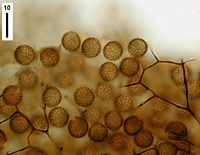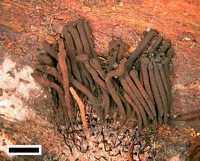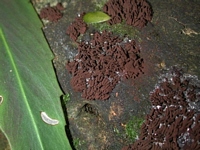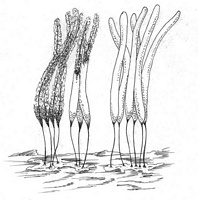|
 Stemonitis fusca Stemonitis fusca
SynonymsStemonitis fusca var. nigrescens
Stemonitis nigrescens
BiostatusPresent in region - Indigenous. Non endemic
Images (click to enlarge)
Caption: reticulate spores
Owner: J.A. Cooper | 
Caption: scale=2mm
Owner: J.A. Cooper | 
Owner: J.A. Cooper | 
Caption: Sporangia of Stemonitis fusca. The individual sporangia are about 15 mm tall.
Owner: S.L. Stephenson | |
Article: Stephenson, S.L. (2003). Myxomycetes of New Zealand. Fungi of New Zealand. Ngā Harore o Aotearoa 3: xiv + 238 p. Hong Kong: Fungal Diversity Press.
Description: Fruiting body a stalked sporangium, tufted and often in large clusters, 6–20 mm tall. Sporotheca cylindrical, erect to sometimes drooping, slender, deep fuscous to dark reddish brown, becoming paler as the spores are dispersed, 0.2–0.3 mm in diameter. Stalk black, shining, rather long, from nearly one-half to one-quarter or less of the height of the entire sporangium. Hypothallus membranous, shining, colourless or brown. Peridium fugacious. Columella dark brown or black, reaching the apex of the sporotheca. Capillitium arising from all parts of the columella, branching and anastomosing freely, the ultimate branchlets united into a close-meshed surface net. Spores fuscous in mass, violet-brown by transmitted light, prominently to delicately warted-reticulate, 7.5–9.0 µm in diameter. Plasmodium white.
Habitat: Decaying wood and bark; less commonly plant debris and bryophytes.
Distribution: Cosmopolitan (Martin & Alexopoulos 1969). First reported from New Zealand by Colenso (1887), based on a specimen from Hawkes Bay. Also known from Auckland, Bay of Plenty, Wellington, Nelson, Mid Canterbury, Dunedin (Lister & Lister 1905), and Stewart Island (Lister & Lister 1905).
Notes: The relatively tall, deep fuscous to dark purplish brown sporangia and reticulate spores are distinctive features of this species, which is very common throughout New Zealand. Stemonitis splendens is similar in appearance but often occurs in larger fruitings and has sporangia with a conspicuously large-meshed surface net and spores that are not reticulate. The concept of S. fusca used herein also encompasses those forms traditionally recognized as S. nigrescens. As pointed out by Castillo et al. (1997), there are not enough morphological differences to maintain the latter as a distinct species.
|